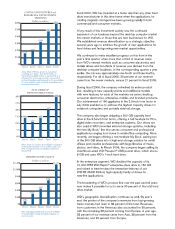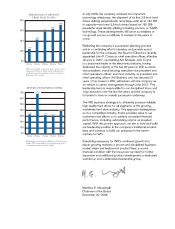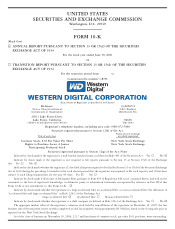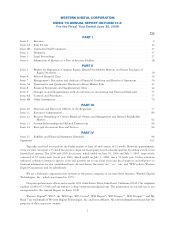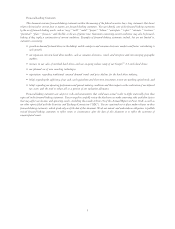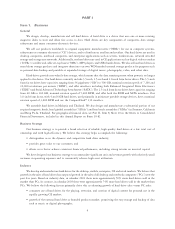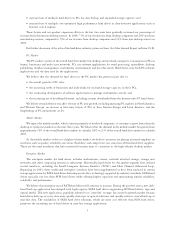Western Digital 2006 Annual Report Download - page 14
Download and view the complete annual report
Please find page 14 of the 2006 Western Digital annual report below. You can navigate through the pages in the report by either clicking on the pages listed below, or by using the keyword search tool below to find specific information within the annual report.Research and Development
We devote substantial resources to development of new products and improvement of existing products. We focus
our engineering efforts on coordinating our product design and manufacturing processes to bring our products to market
in a cost-effective and timely manner. Research and development expenses totaled $297 million, $240 million and
$202 million in 2006, 2005 and 2004, respectively.
For further discussion of risks related to our development of new products, see Item 1A of this Annual Report on
Form 10-K.
Technology and Product Development
Hard drives record, store and retrieve digital data. Performance attributes of hard drives, such as their ability to
access and transmit data and storage capacity, are currently better than removable or floppy disks, optical hard drives and
tapes, and they are more cost effective than semiconductor technology. The primary measures of hard drive performance
include:
• “Storage capacity” — the amount of data that can be stored on the hard drive — commonly expressed in GB. As
defined in the hard drive industry, one GB equals one billion bytes. A byte is a digital character, typically
comprised of eight bits. A bit is a binary digit, the smallest unit of information in a digital system.
• “Average seek time” — the time needed to position the heads over a selected track on the disk surface —
commonly expressed in milliseconds.
• “Internal data transfer rate” — the sustained rate of data transfer to and from the disk — commonly expressed in
megabits per second. One megabit equals one million bits.
• “Spindle rotational speed” — the nominal rotational speed of the disks inside the hard drive — commonly
expressed in RPM, revolutions per minute or latency. Spindle rotational speeds commonly stated as 5,400, 7,200
and 10,000 RPM are sometimes approximations.
• “Acoustics” — the sound power emitted during hard drive operation — commonly expressed in decibels.
All of our hard drive products employ similar technology. The main components of the hard drive are a head disk
assembly and a printed circuit board. The head disk assembly includes heads, media (disks), head positioning mechanism
(actuator) and spindle motor. A hard base plate protective package in a contamination-controlled environment contain
these components. The printed circuit board includes both standard and custom integrated circuits, an interface
connector to the host computer and a power connector.
One or more disks positioned around a motor-driven spindle hub that rotates the disks comprises the head disk
assembly. A thin coating of magnetic materials applied to a smooth substrate make the disk. Each disk has a head
suspended directly above it, which can read data from or write data to the spinning disk.
The integrated circuits on the printed circuit board typically include a drive interface and a controller. The drive
interface receives instructions from the computer, while the controller directs the flow of data to or from the disks and
controls the heads. The location of data on each disk is logically maintained in concentric tracks divided into sectors. The
computer sends instructions to the controller to read data from or write data to the disks based on logical track and sector
locations. Guided by instructions from the controller, the head stack assembly pivots and swings across the disk by a head
actuator or motor until it reaches the selected track of a disk, where the data is recorded or retrieved.
Industry standard interfaces allow the hard drive to communicate with the computer. Currently, the primary
interfaces for PCs are EIDE and SATA, and the primary interface for enterprise systems is SCSI. As computer performance
continues to improve, the hard drive will need to deliver information faster. We believe this will continue to drive the PC
industry transition to higher speed interfaces, such as SATA, to handle the higher data transfer rates. We currently offer
our WD Caviar», 7,200 RPM drives with the SATA interface and featuring capacities as large as 500 GB. We design these
products for the PC, workstation, server, and external storage markets. We believe that SATA is also becoming a more
popular interface in the enterprise market. We currently offer our WD Raptor», a 10,000 RPM enterprise-class drive
with the SATA interface, and the WD Caviar»RE and RE2, 7,200 RPM drives manufactured to enterprise-class
standards and available with a SATA interface.
8


